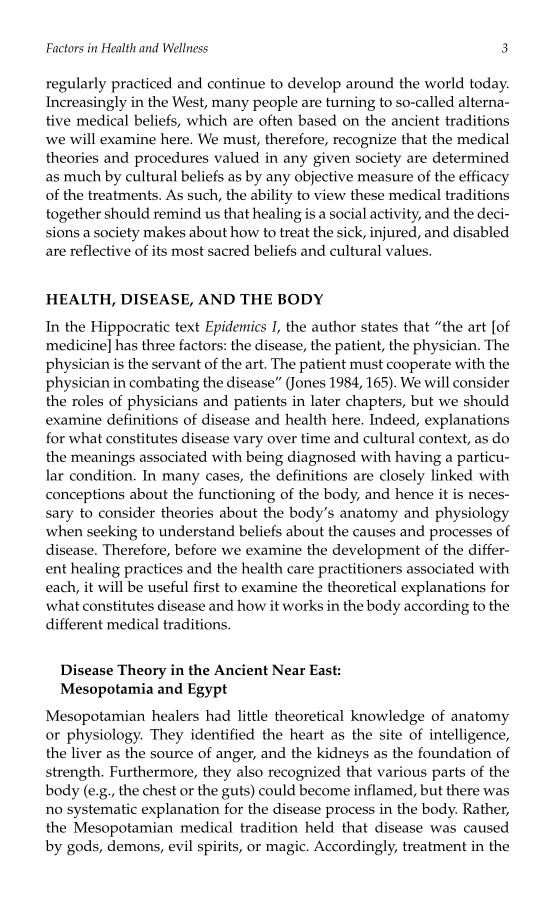Factors in Health and Wellness 3 regularly practiced and continue to develop around the world today. Increasingly in the West, many people are turning to so-called alterna- tive medical beliefs, which are often based on the ancient traditions we will examine here. We must, therefore, recognize that the medical theories and procedures valued in any given society are determined as much by cultural beliefs as by any objective measure of the efficacy of the treatments. As such, the ability to view these medical traditions together should remind us that healing is a social activity, and the deci- sions a society makes about how to treat the sick, injured, and disabled are reflective of its most sacred beliefs and cultural values. HEALTH, DISEASE, AND THE BODY In the Hippocratic text Epidemics I , the author states that “the art [of medicine] has three factors: the disease, the patient, the physician. The physician is the servant of the art. The patient must cooperate with the physician in combating the disease” (Jones 1984, 165). We will consider the roles of physicians and patients in later chapters, but we should examine definitions of disease and health here. Indeed, explanations for what constitutes disease vary over time and cultural context, as do the meanings associated with being diagnosed with having a particu- lar condition. In many cases, the definitions are closely linked with conceptions about the functioning of the body, and hence it is neces- sary to consider theories about the body’s anatomy and physiology when seeking to understand beliefs about the causes and processes of disease. Therefore, before we examine the development of the differ- ent healing practices and the health care practitioners associated with each, it will be useful first to examine the theoretical explanations for what constitutes disease and how it works in the body according to the different medical traditions. Disease Theory in the Ancient Near East: Mesopotamia and Egypt Mesopotamian healers had little theoretical knowledge of anatomy or physiology. They identified the heart as the site of intelligence, the liver as the source of anger, and the kidneys as the foundation of strength. Furthermore, they also recognized that various parts of the body (e.g., the chest or the guts) could become inflamed, but there was no systematic explanation for the disease process in the body. Rather, the Mesopotamian medical tradition held that disease was caused by gods, demons, evil spirits, or magic. Accordingly, treatment in the
Document Details My Account Print multiple pages
Print
You have printed 0 times in the last 24 hours.
Your print count will reset on at .
You may print 0 more time(s) before then.
You may print a maximum of 0 pages at a time.

















































































































































































































































































